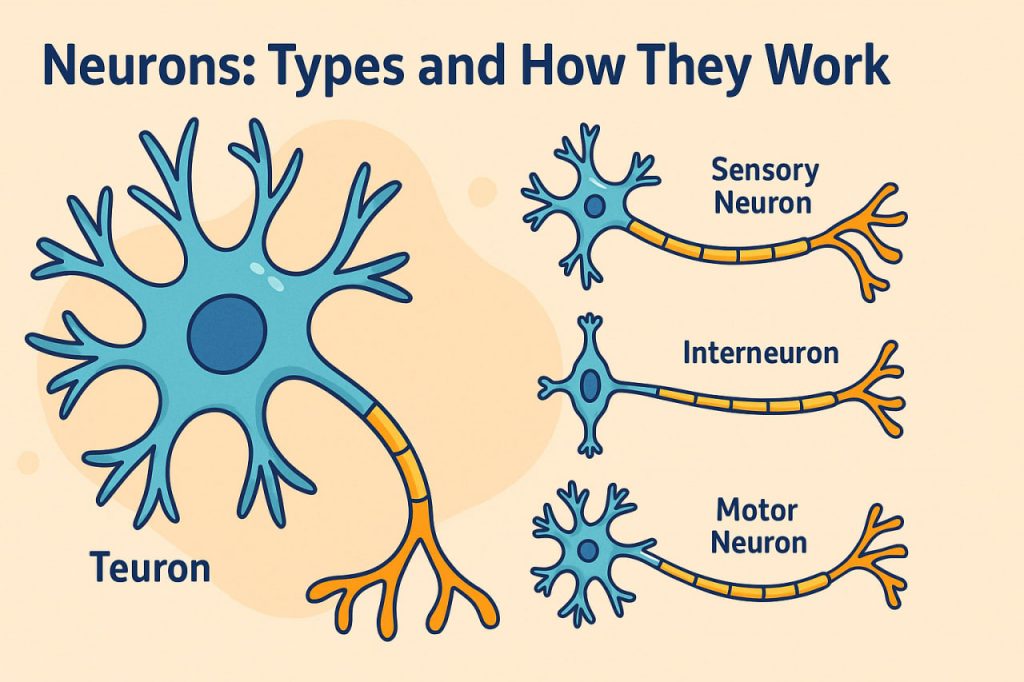Neurons are the basic building blocks of the nervous system, responsible for transmitting information throughout the body. They are specialized nerve cells that communicate using electrical and chemical signals. Unlike other cells, neurons are uniquely designed to process and transmit information across long distances. They form vast networks that control everything from simple reflexes to complex thoughts. The human brain contains about 86 billion neurons, each with thousands of connections, creating one of the most complex systems in nature.
Structure of a Neuron
A neuron has three main parts: the cell body (soma), dendrites, and axon. The soma contains the nucleus and maintains the cell’s health. Dendrites receive signals from other neurons, acting like branches that collect information. The axon, a long fiber, transmits electrical impulses away from the cell body toward other neurons, muscles, or glands. At the end of the axon are synapses, where neurons communicate using chemical messengers called neurotransmitters. This structure allows neurons to be highly efficient in passing signals.
Types of Neurons
Neurons are classified based on their function and structure. Sensory neurons carry information from the body’s sensory organs to the brain, allowing us to see, hear, and feel. Motor neurons send signals from the brain and spinal cord to muscles, controlling movement. Interneurons connect neurons within the brain and spinal cord, playing a central role in processing information. Structurally, neurons can be unipolar, bipolar, or multipolar, depending on how many extensions they have. These variations suit different functions in the nervous system.
How Neurons Work
Neurons transmit information through a combination of electrical and chemical processes. An electrical signal, called an action potential, travels along the axon. When it reaches the synapse, neurotransmitters are released into the gap between neurons. These chemicals then bind to receptors on the next neuron, passing along the message. This rapid communication system allows the brain to coordinate movement, thoughts, and emotions in fractions of a second. Neurons can fire thousands of times per second, demonstrating their incredible efficiency.
The Role of Neurotransmitters
Neurotransmitters are chemicals that make communication between neurons possible. For example, dopamine regulates motivation and reward, serotonin influences mood, and acetylcholine controls muscle activity. Different neurotransmitters are essential for different brain functions, and imbalances can contribute to mental or neurological disorders. By studying neurotransmitters, scientists develop treatments for conditions such as depression, Parkinson’s disease, and Alzheimer’s disease. These chemical signals are vital for maintaining healthy brain activity.
Importance of Neurons in Daily Life
Every thought, memory, and movement depends on neurons. They enable learning, decision-making, and creativity by forming new connections through a process called neuroplasticity. Damage to neurons, caused by injury or disease, can disrupt communication in the nervous system, leading to serious conditions like paralysis or memory loss. Understanding neurons not only explains how the brain functions but also offers insight into treating neurological and psychiatric disorders.
Conclusion
Neurons are the fundamental units of the nervous system, uniquely structured to transmit information rapidly and precisely. They exist in different types, each with specialized roles, and they communicate through electrical impulses and neurotransmitters. By working together in vast networks, neurons enable everything from simple reflexes to complex human behavior. Studying neurons continues to reveal the secrets of the brain and provides hope for medical advances in treating neurological diseases.
Glossary
- Neurons – nerve cells that transmit information in the nervous system.
- Nervous system – the body’s network of brain, spinal cord, and peripheral nerves.
- Cell body (soma) – the main part of a neuron containing the nucleus.
- Dendrites – neuron extensions that receive signals.
- Axon – a long fiber transmitting electrical signals away from the neuron.
- Synapse – the junction where neurons communicate using neurotransmitters.
- Neurotransmitters – chemical messengers that transmit signals between neurons.
- Neuroplasticity – the brain’s ability to adapt by forming new neural connections.


